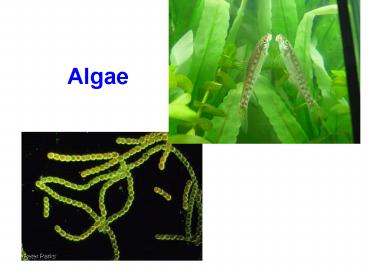Algae - PowerPoint PPT Presentation
1 / 21
Title:
Algae
Description:
Algae Algae diverse simple mostly aquatic mostly photosynthetic Belong to the kingdom Protista Eukaryotic So they have a nucleus and membrane bound organelles ... – PowerPoint PPT presentation
Number of Views:970
Avg rating:3.0/5.0
Title: Algae
1
Algae
2
Algae
- diverse
- simple
- mostly aquatic
- mostly photosynthetic
- Belong to the kingdom Protista
- Eukaryotic
- So they have a nucleus and membrane bound
organelles
3
- Photosynthesis takes place in chloroplasts
- They can be either
- Green
- Brown
- Red
4
How are they different from plants?
- No flowers
- Simple reproductive structures
- Lack leaves, roots, and stems
5
Diatoms
- Unicellular organisms that are usually planktonic
- Cell walls made of glass-like Silica
- The glassy shell is called a frustule
- Has two halves and resembles a box
6
Diatom Reproduction
Frustules get smaller and smaller.
Why do diatoms get extremely small during periods
of high reproduction called blooms?
- Usually asexual reproduction
7
Ooze
- When diatoms die, their glassy shells sink to the
bottom of the ocean creatingdiatomaceous ooze - Does that sound familiar?
- Mined and used in things like
- Swimming pool filters
- Toothpaste
- Temperature and sound insulators
8
Dinoflagellates
- Two flagella
- one wrapped around a groove along the middle of
the cell - One trailing behind it
- Cell wall made of plates of cellulose
9
Zooxanthellae
- Special dinoflagellate that lives in close
association with coral and other animals - In coral, they photosynthesize and the coral uses
the nutrients released by them
10
Special Dinoflagellates
- Some are bioluminescent
- Some release toxic substances during large blooms
11
Pfiesteria
- Phantom dinoflagellate
- Parasite that feast on fish
- Cause open sores in fish
- Temporary memory loss in humans
12
Protozoans (animal like protists)
- Foraminiferans
- Shell made of calcium carbonate
- Pseudopodia to trap diatoms to eat
Homotrema rubrum is a foram that is bright red
and lives on corals. Very common in Bermuda
skeletons made the islands famous pink beaches.
13
Radiolarians
- Spherical
- Shells of silica
- Pseudopodia to eat
14
Ciliates
- Many hair like extensions called cilia to move
- Very common as freshwater Paramecium
15
Multicellular Algae
- Seaweed
- Sometimes called macrophytes or macroalgae
- Also eukaryotic
- Can range from small to large
- Kelp often form large forests underwater
16
Structure
- Lack true leaves, stems, and roots
- Entire body is called the thallus
- Leaf-like flattened portions are called blades
- Pneumatocysts are gas filled chambers that keep
blades close to surface to maximize photosynthesis
17
- Some seaweed have a support called a stipe where
blades originate - Holdfast holds thallus to ground
18
Types of seaweed
- Green algae
- Most live in freshwater
- Brown algae
- Largest, most complex seaweeds
- Kelp
- Red algae
- More marine red than brown and green combined
19
Economic Importance
- Mariculture farming of seaweed is big in China,
Japan, and Korea - Phycocolloids are gellatins used in many foods
- Algin used to stabilize foods
- And much more
20
Seagrasses
- Not algae
- Actually adapted land plants that live in water
- Roots grow sideways under sediment
- Provide homes to many organisms
21
- Castro, Peter and Huber, Michael E. Marine
Biology. New York McGraw-Hill, 2007.































